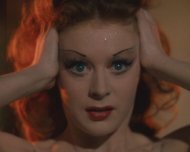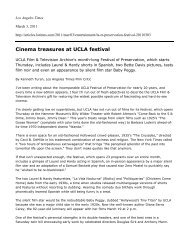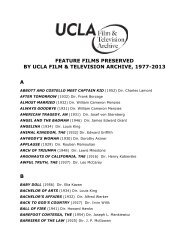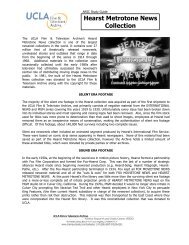"Heroic Grace" catalog - UCLA Film & Television Archive
"Heroic Grace" catalog - UCLA Film & Television Archive
"Heroic Grace" catalog - UCLA Film & Television Archive
Create successful ePaper yourself
Turn your PDF publications into a flip-book with our unique Google optimized e-Paper software.
fighting arts, which allows for extended action scenes. For instance, the<br />
school can be pitted against a rival school advocating a different style,<br />
as in the earliest US kung fu imports such as FIVE FINGERS OF DEATH (TIAN<br />
XIA DI YI QUAN, 1971) and Bruce Lee’s THE CHINESE CONNECTION (a.k.a. FIST<br />
OF FURY/JINGWU MEN, 1972).<br />
The 1970s also brings one of the most characteristic strategies for<br />
stretching out the story—the insertion of comic interludes. While King<br />
Hu’s and Zhang Che’s 1960s masterworks benefit from a fairly unified<br />
tone, the arrival of comic kung fu in the mid-1970s seems to have invited<br />
filmmakers to plug in facetious moments. Often these are just tiresome,<br />
but sometimes they create a forceful counterpoint. LEGENDARY WEAPONS<br />
OF CHINA centers on the Boxer Rebellion and secret societies longing to<br />
create an invulnerable kung fu, but a farcical interlude with fake intestines<br />
and voodoo-like dolls makes fun of the Boxers’ blindness and<br />
obedience to their masters. Often one film can comically invert another,<br />
as when in RETURN TO THE 36TH CHAMBER, Lau Kar-fai (Gordon Liu Jiahui)<br />
parodies the steely training regimen set forth in the earlier film.<br />
By mixing and matching heroes, villains, fighting traditions, master/<br />
student relationships, and contrary tones, martial arts moviemakers<br />
arrived at what we might call an “additive” conception of plot. Episodes<br />
and off-center incidents casually fill out the overall structure. Characters<br />
come and go, new villains may be introduced fairly late, chance<br />
meetings may provoke fights or inspiration (e.g., the discovery of a<br />
combat technique by noticing an animal’s predatory strategies). By the<br />
standards of western plotting (a three-act structure, with carefully<br />
planted foreshadowings and tight scene linkages), martial arts movies<br />
look fairly ramshackle. But across world history, this approach may be<br />
far more common than the Aristotelian model. Accretive, episodic storytelling<br />
harks back to folk literature in many cultures. “This, and therefore<br />
that” is replaced by “This…and then that…and then that.”<br />
Simple as they are, these storytelling ingredients can be combined in<br />
a virtually infinite number of ways. Consider Lau Kar-leung’s EXECUTION-<br />
ERS FROM SHAOLIN (HONG XIGUAN, 1977). The driving impetus for the plot<br />
is, as usual, vengeance: Hong Xiguan (Chen Guandai) must avenge himself<br />
on Bai Mei (Luo Lie), the white-eyebrow priest who burned the Shaolin<br />
Temple, killed Hong’s master, and led to the death of Hong’s best friend<br />
and Shaolin “blood brother.” Although Hong marries and has a child, he<br />
nourishes the desire to defeat Bai Mei and practices to perfect his kung<br />
fu. There is a subsidiary villain as well, a corrupt official promoted<br />
thanks to Bai Mei’s treachery. Individuals are distinguished less by psychology<br />
than by their adherence to a martial arts school. Hong’s commitment<br />
to the Tiger Style is balanced by the expertise in the Crane Style<br />
displayed by his wife, Fang Yongchun, also known as Swan (Li Lili), which<br />
she urges him to master as well. Hong tries twice to kill Bai Mei, dying in<br />
the second attempt. In the meantime, the couple’s son Wending (Wong<br />
Yu, not to be confused with Wang Yu of ONE-ARMED SWORDSMAN fame)<br />
becomes a jaunty kung fu adept. Both his mother’s and father’s boy, he<br />
fluidly blends their styles and, with a few fillips of his own, avenges his<br />
father’s death.<br />
Spanning several years, EXECUTIONERS FROM SHAOLIN binds its scenes<br />
together with training sessions and comic skirmishes between husband<br />
and wife, father and son. There are also seriocomic motifs of a sometimes<br />
startling carnality. On their wedding night, Hong cannot consummate<br />
his marriage because for all his skill he cannot make Swan open her<br />
legs! Only when he finds her qi-governed weak points does she unlock<br />
her limbs. Later, Hong knows that Bai Mei’s weak point is his crotch, and<br />
he attacks it vigorously—only to find his foot stuck deep there. (Bai Mei,<br />
it turns out, has mastered his qi to such an extent that he can shift his<br />
weak point from his crotch to his skull.) Still later, the son Wending<br />
11<br />
attacks Bai Mei’s crotch once more, but this time he eludes the master’s<br />
trap. Instead, he reverts to a trick he discovered as a child: leaping to<br />
his father’s shoulders and locking his legs there for a free ride. Now surmounting<br />
Bai Mei, Wending can ride him relentlessly, slamming his temples<br />
and jabbing his eyes until the old villain stumbles forward. Dying,<br />
Bai Mei plunges down a steep flight of steps—the very staircase down<br />
which he had hurled Hong in an earlier bout. Such symmetries make<br />
revenge particularly sweet.<br />
FASCINATING RHYTHM<br />
Cathay, Shaw Brothers and other companies sought to turn out films<br />
fast, and with tight budgets it was better to invest in sets and set pieces<br />
than in script development. Squeezed for time and money, proceeding<br />
intuitively, these filmmakers managed to add to the resources of world<br />
film language.<br />
The fundamental materials, of course, are the athletic fighting styles<br />
on display, halfway between acrobatics and dance. One can relish these<br />
movies just for the choreography, as many film buffs sit through the<br />
plot longueurs of Fox musicals. But the most ambitious filmmakers went<br />
beyond simply recording martial arts stunts, creating something purely<br />
filmic by new approaches to cutting, framing and camera movement.<br />
The early WONG FEI-HUNG entries of the late 1940s and early ’50s are of<br />
cultural interest, but they hardly represent strong filmmaking. By the<br />
time Shaw and Cathay launched their swordplay cycles in the mid-1960s,<br />
though, directors had begun creating a rich and bravura style.<br />
Over the period of Hong Kong’s rise, Hollywood was picking up its<br />
editing pace. A 1950s movie would average around 8-11 seconds per shot,<br />
but from the 1960s on, 7 seconds or less became common. Hong Kong<br />
martial arts filmmakers pushed the envelope much further. A slow-ish<br />
kung fu film of the 1970s would average 6 seconds per shot, while some<br />
directors—King Hu, the Shaw stable—took things down to 4 seconds or<br />
so. The films of Sammo Hung and Jackie Chan routinely averaged 2-3 seconds<br />
per shot, as did Tsui Hark’s ZU: WARRIORS FROM THE MAGIC MOUNTAIN<br />
(SAN SOOK SAN KIM HAP/XIN SHUSHAN JIANXIA, 1983) and the gunplay sagas<br />
of John Woo.<br />
Today’s Hollywood directors also cut swiftly, but the similar shot<br />
totals disguise some basic differences of approach. A rapidly edited<br />
passage in a US action film of the 1990s looks mostly unintelligible, the<br />
rapid cutting making it hard to discern what’s going on. Hong Kong editing<br />
triumphed through its commitment to legibility, making the key<br />
components of the action carry over clearly from shot to shot. Not that<br />
some things aren’t faked. (It’s hard to make a punchee fly 20 feet without<br />
some fudging.) Rather, the action is reduced to simple elements—a single<br />
vector of action, a bold jab of color, even just the twist of a neck or a<br />
face popping up from the bottom frameline—that allow the spectator’s<br />
eye to track a continuous, pulsating pattern of movement. “Pulsating” is<br />
the key term here, because along with the simplicity of pictorial design<br />
comes a staccato rhythmic pattern which not only clarifies the action<br />
but exhilarates the viewer.<br />
Two approaches emerged. The older generation learned to stage and<br />
cut action around rhythmically articulated long shots. The traditions of<br />
martial arts and theatrical performance broke the action into percussive<br />
bursts followed by fractional seconds of stasis. After a punch, a pause;<br />
after a leg lashes out, a moment of equilibrium. Conventional wisdom<br />
held that you couldn’t cut long shots fast; there was too much information<br />
in them. But the great choreographers such as Han Yingjie (in his

















